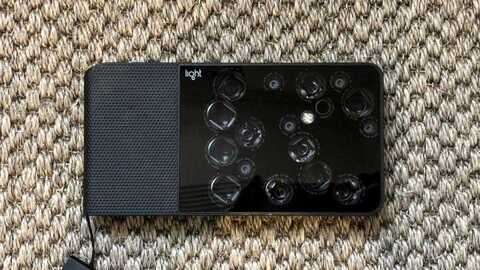Light L16: Everything you need to know about the 16-lens camera
A smartphone with a single camera is no longer deemed Instagram-worthy, and secondary camera arrangements are now commonplace. Heck, there’s even a triple-camera smartphone rumoured to be on the way from Huawei , but what if three cameras weren’t enough to satisfy the prolific internet blogger?
Well, Light’s latest L16 camera offers exactly that: with a grand total of 16 cameras and the capacity to capture 52-megapixel stills. Trypophobics look away: here’s absolutely everything you need to know about the Light L16, including UK release date, price, specifications and more.
Light L16: Everything you need to know
Light L16 UK price: How much does it cost?
Let’s get the most crucial bit out of the way first: the Light L16 ain’t cheap. That’s to be expected of a device with 16 camera lenses strapped to it, but the L16’s £1,850 asking price really takes the biscuit.

To put that price into an absurd context, you can buy 16 Moto G5 smartphones and glue them all to a slab of balsa wood at that price. Although, of course, the picture you'd take with that monstrosity almost certainly wouldn’t make it to your Instagram profile.
Still, if you buy the Light L16 before the end of March, you’ll only have to pay £1,295 – that’s 30% off. Bargain.
Light L16 UK release date: When will it launch?
The Light L16 is available now and can be purchased directly from the official Light website . To reiterate what I said above, you get 30% off your purchase if you buy one before 31 March.

Light L16: Design, features and first impressions
The L16 is about the size of a small transistor radio. It weighs 435g and its – almost pocketable – brick-like form factor is considerably less awkward than the DSLRs it wants to replace. It has a rubber grip on the side and a 5in touchscreen on the rear, and you take pictures with it just like you would a normal smartphone.
Behind the scenes, the L16 runs Android and is powered by a Qualcomm Snapdragon 820 processor, with 256GB of onboard storage. It also has Wi-Fi and Bluetooth connectivity, GPS and a 4,120mAh battery that lasts eight hours on a single charge.

It might look like a chunky smartphone, but the L16 is nothing of the sort. Its arrangement of 16 13-megapixel cameras produces 52-megapixel still images, which offer an equivalent of 5x optical zoom spread across three focal lengths: 28mm, 70mm and 150mm. You can also adjust the depth of field in your images after taking the picture.
Light L16: How does it work?
That all sounds very impressive, but how does the Light L16’s camera array work? As soon as you press the shutter button, the camera takes ten, 13-megapixel pictures in quick succession. The images are then stitched together, overlaying them on top of each other to create a 52-megapixel image. This process helps to keep visual noise at bay and increases dynamic range.
The camera can shoot in automatic mode or fully manual, with focus achieved by tapping the subject on the screen or simply pressing the shutter button. There’s no aperture priority, although the camera is able to run from 100 to 3200 ISO sensitivity levels.
Because there’s so much data to handle, the camera itself is unable to stitch all of the images together. You need to plug the L16 into your PC or laptop to do this, with all the image data transferred into Light’s own software application, Lumen, in a specialised LRI format.
Once you’ve plugged it in and transferred the image data across, your PC will then merge your shots into one and you can adjust the depth of field of the image. Your picture will then be exported in DNG format for post-processing in Photoshop or Lightroom.
Light L16: Early verdict
Light’s new L16 camera, despite its bug-eyed appearance, is an enticing development in small-form-factor camera technology. It may not be perfect – early reviews suggest poor depth-mapping and sluggish autofocus among other flaws – but its fancy tech shows promise, and could pioneer the future of smartphone photography.